|
My Own Back Yard
colored pencil and watercolor
26” x 36"
1997
“If I ever go looking for my heart’s desire again, I won’t look any further than my own back yard because if it isn’t there, I never really lost it to begin with.”
|
|
(Dorothy in MGM’s The Wizard of Oz) |
| |
For eighteen years I lived in a place as enchanting to a nature lover as the Land of Oz was to Dorothy Gale of Kansas. Originally developed as a suburb of Baton Rouge in the 1940s, the neighborhood, with its half acre lots and mature trees, retains a feeling of wilderness in what is now the middle of the city. An amazing variety of wildlife finds refuge there, with representatives from most of the zoological phyla. Plant life is abundant and lush: juxtaposed with the introduced exotic plants are the tenacious native species with their own charms.
My back yard was my refuge from the stresses of life as well as a source of inspiration for my art. In the year before I moved, I kept a careful record of my outdoor observations from month to month. The resulting twelve drawings are my tribute and my farewell to the garden that was my muse. |
| |
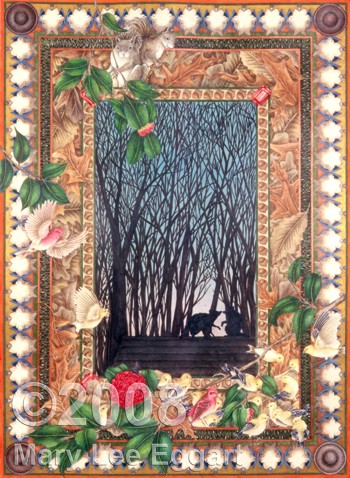 |
|
January
Named in honor of the two-faced Roman god Janus, the god of gates and doors and beginnings. . . he is represented by my aunt and uncle’s long-lived Siamese cat, Jana (the female equivalent of Janus)
. . . the circles behind the cat’s head indicate Janus’s association with wholeness and eternity ( he sees both past and future) . . .the head of Janus was mounted on “terms,” the Roman pillars that marked property lines. . .at the four corners of the drawing are the cast iron markers that indicate the property lines of my yard. . .gold crowns commemorate the coming of the kings on the feast of the Epiphany, January 6. . .the huge camellia at the corner of the garage is abundantly in bloom. . .squirrels hunt for acorns among the leaves that still lie where they fell last autumn . . goldfinches in their drab winter plumage join purple finches to feed on the sunflower seed in the feeders. . .raccoons court loudly on my roof in the middle of the night. . . birthstone: garnet |
| |
|
|
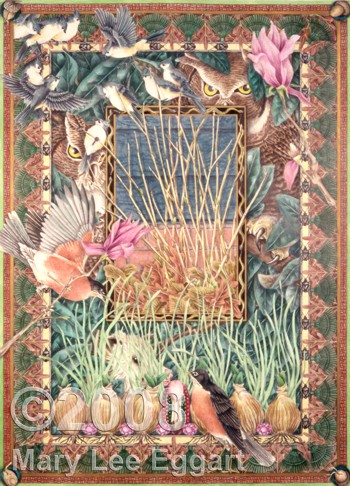 |
|
February
From the Latin februare: “to cleanse or purify”. . . the month I finally rake the leaves. . . border motif of lawn rakes and oak leaves. . . my rake uncovers the foul-smelling leaf-footed bugs and in low, moist spots, wakes up the garden snakes. . . hundreds of last year’s acorns roll out, just beginning to send out their first shoots . . . my year-round pair of robins feast on critters the rake stirs up. . . at night, the possum takes his opportunity to root in the freshly exposed ground. . .great horned owls hoot their courtship songs in the magnolias. . . first hint of green on the brown hydrangea stems. . . Japanese magnolias open their purple flowers. . . busy titmice. . .I arrange wheelbarrow loads of brick in a basketweave pattern for an impromptu patio. . .bulbs send up their green leaves. . . the pink flamingo of Spanish Town Mardi Gras. . . birthstone: amethyst |
| |
|
|
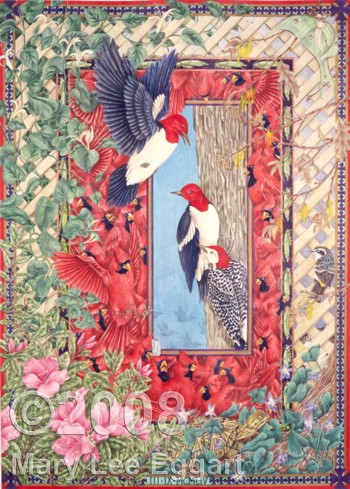 |
|
March
Named for Mars, the Roman god of war. . . Mars, the red planet . . .red is my favorite color. . .March is the month of my birth. . . red cardinals. . .red-headed and red-bellied woodpeckers on the oak trees. . . cats watch the birds through the lattice on the porch . . . yellow-rumped myrtle warbler. . . the beginning of spring . . . oak tree tassels cover everything with yellow pollen. . . honeysuckle vines flower. . . delicate wild violets appear in the spaces between the roots of trees. . .azaleas bloom. . . pelicans fly by on their spring migration. . . working in the flower beds, I often run across the large box turtle who has lived there for years. . . katydids. . . the luna moth whose life I saved by keeping him inside during a late frost. . . purple crosses for Lent . . . birthstone: aquamarine |
| |
|
|
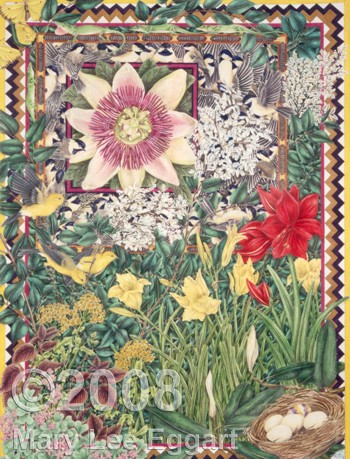 |
|
April
From the Latin aprilis: “to open”. . . and everything does open. . . ligustrum. . . butterweed. . . hay fever. . . yellow daylilies. . . red amaryllis. . .velvety shoots of new magnolia leaves. . . lavender oxalis. . . purple coleus. . . yellow sulfur butterflies. . . green anole lizards puff up their pink throats. . . fearless and noisy chickadees . . . prothonotary warblers. . .the flowers of the Passion vine open in time for Good Friday. . . the brown thrashers make a nest in the camellia by the garage while mockingbirds choose the ligustrum by the front door. . . eggs in time for Easter. . . birthstone: diamond |
| |
|
|
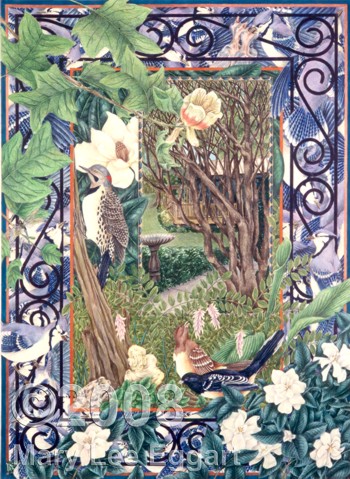 |
|
May
Named for Maia, the mother of Hermes and goddess of spring. . .later, it became the month that honors the Blessed Virgin Mary . . blue is Mary’s color. . . blue jays are everywhere . . . yellow-shafted flickers hammer at insects on the tree trunks. . . a pair of rufous-sided towhees are always digging in the leaf mulched flower beds, tossing leaves everywhere. . . wrought ironwork decorates the front porch. . . ginger lily leaves unfurl. . . magnolias in flower. . .the tulip poplar is finally mature enough to bloom. . . ornamental indigo flowers. . .tiny wild strawberry plants. . . I planted so many gardenia bushes that the scent of their flowers surrounds the whole yard. . .doodle bugs. . . amazing lichens grow on dead wood. . . mosquito hawks patro l. . there seems to be a southern toad in every damp spot. . . a view from the back corner of the garage through the trunks of my favorite sasanqua to my porch and deck. . . birthstone: emerald |
| |
|
|
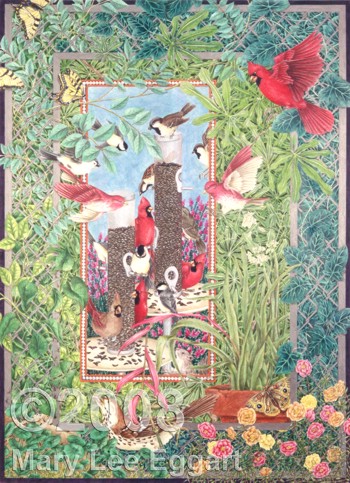 |
|
June
Named for the Roman clan Junus. . . flowers and vegetation become almost oppressive. . . vines establish themselves inexorably on the chain link fence. . . English ivy. . . trumpet vine . . . wisteria. . . passion vine. . . poison ivy. . . many more I can’t identify. . . crape myrtles bloom. . .the manihot trees produce flowers for the first time . . . June 6, the feast of the Sacred Heart: fire ants form a crown of thorns around the heart-shaped leaf. . .the bromeliads send out flowers. . .portulaca, which I used to plant with my grandfather when I was a child. . . dollar weed softens the edges of the drainage ditch and makes it look like a small stream bed. . . plenty of bird activity at the feeders. . cardinals. . . chickadees. . .titmice. . . purple finches. . . squirrels shimmy up the feeder poles to get their share. . . brown thrashers thrashing in the undergrowth. . . buckeye moth. . . swallowtails. . birthstone: pearl |
| |
|
|
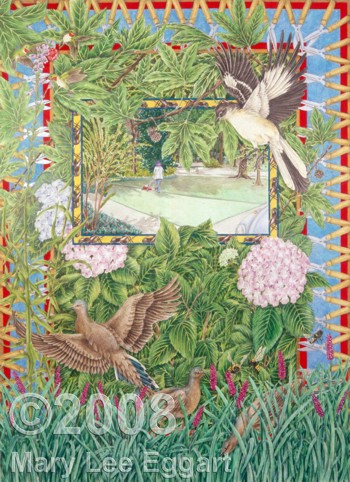 |
|
July
The month named for Julius Caesar. . . overwhelmed by green . . bumblebees buzz over the purple liriope flowers . . . the lavender obedient plant flowers are visited by fiercely territorial ruby-throated hummingbirds. . . mourning doves hunt for food under the feeders. . . the sweetgum tree in the middle of the deck is thickly foliated. . . hydrangeas flower later in my yard than in most others. . . Mama drives over in her 1968 VW bug to mow the lawn for me every week . . .meanwhile, I try to gain some control over the beds and shrubs. . . my pruning shears form the border. . . the mockingbirds take advantage of the crickets and other bugs that are stirred up by the mower. . .birthstone: ruby |
| |
|
|
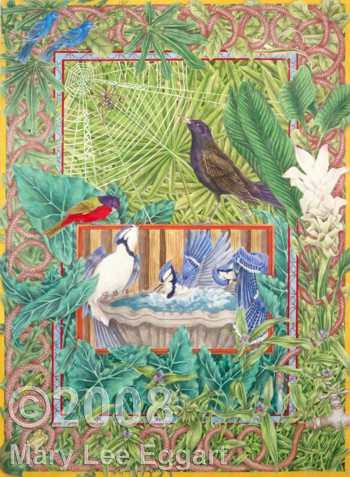 |
|
August
Named for Augustus Caesar. . . the month we really get sick of the heat. . .so hot that everything seems to need constant watering even when there’s been recent rain. . . the five-lined skinks enjoy the resulting moisture. . . mosquitoes, unfortunately, also flourish . . .the praying mantis helps keep the population a little in control. . . I try to keep the bird baths filled with fresh water for the enjoyment of blue jays and others. . . the grackles drive off the smaller birds occasionally, and I always expect their iridescent black feathers to leave an oil slick on the water. . .ancient red oaks and water oaks provide some shade and some relief. . . elephant ears and palmettos thrive in the shadiest corners. . . the stalky plant under the birdfeeders produces its small blue flowers and, later, strange pods. . . ginger lilies bloom. . . a golden silk spider weaves a spectacular web between ligustrums across a walkway . . . I hang a bright ribbon there so I’ll remember to duck and not destroy her work. . . painted buntings and indigo buntings are rare visitors . . .birthstone: peridot |
| |
|
|
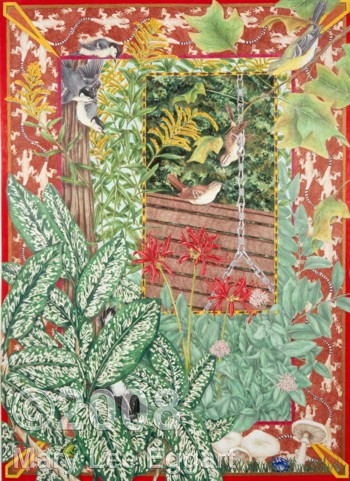 |
|
September
Originally, the seventh month of the year in the ten-month Roman calendar. . . the first hint of autumn. . . goldenrod makes spectacular fields of yellow and spectacular allergy attacks. . .the tulip tree leaves are the first to start turning their fall colors. . . diffenbachias have reached the height of their growth for this year. . . the succulent-like plant from my grandmother’s house begins to bloom. . . spider lilies send up their stalks of red flowers seemingly overnight (another name for them is surprise lilies). . . mushrooms appear . . . the ubiquitous love bugs come out to annoy us. . . nuthatches skitter up and down the trunk of the sweetgum tree. . . Carolina wrens play on the deck swing and its chain. . . yellow-throated vireos. . . I never actually saw the skunk, but I could tell he was around. . .tiny green tree frogs. . . the strange pink geckos (newts? salamanders?) with the striped tails that I’ve only seen the past couple of years. . .they hung on the porch screens at night and excited the cats. . . birthstone: sapphire |
| |
|
|
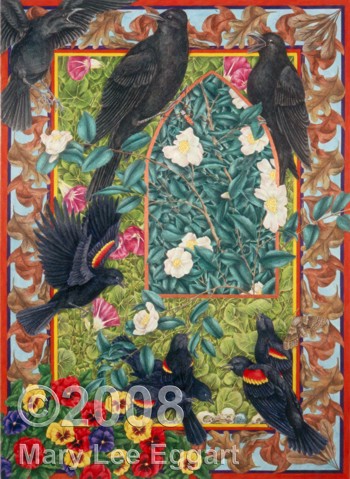 |
|
October
The eighth month of the Roman year. . . leaves are beginning to fall in earnest. . . morning glory vines and their spectacular violet flowers. . . velvety pansies are in bloom. . . camellia sasanquas open their delicate pink flowers that smell like gardenias, only not so strong. . . a gothic arch and some orange and black for Halloween. . . the crows fuss and caw from the sky and treetops but rarely light on the ground . . .red winged black-birds. . . even this late in the year, the silver argiope spider is still spinning. . sphinx moth. . . when I used to let the cats out, they’d sometimes add to my collection of bird skulls. . . birthstone: opal |
| |
|
|
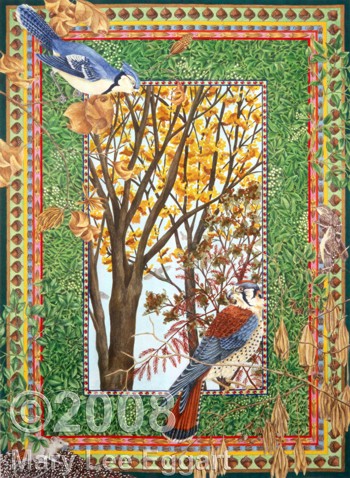 |
|
November
The ninth month of the Roman year. . . enough leaves have fallen for the trees to look bare. . .with so much foliage gone, the hawks and kestrels that have been circling in the sky all summer are more easily seen. . . the blue jays scream at them. . .the tree in the back corner turns brilliant yellow and glows when it catches the light near sunset. . . ladybugs . . . as winter approaches, the brown creepers return, their striped brown feathers keep them camouflaged on the tree trunks. . .it’s harvest time, with all the trees sending out their seeds. . .the winged seeds of the tulip poplar break off from their cones and flutter one by one to the earth. . . on a windy night, the acorns falling on the metal porch roof sound like machine gun fire. . . I collect the first seeds these manihot trees have ever produced in hopes of raising some for my new yard. . .in the bucket where I store sunflower seed, a mouse has taken up residence. . .he is quite fat by the time I discover him . . . I dump him out under the birdfeeders and hope he won’t return to the storeroom. . .the nandina bushes have small green berries that will turn red by the end of the month. . . birthstone: topaz |
| |
|
|
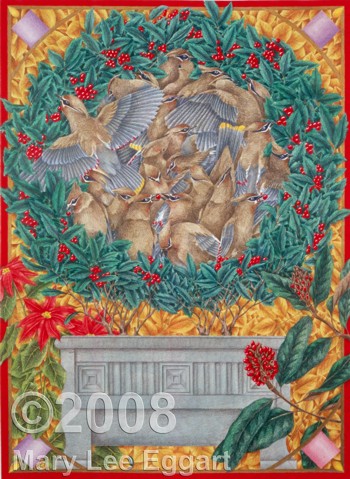 |
|
December
The last month of the year. . . candles in traditional liturgical colors represent the season of Advent. . . magnolia cones spit out their bright red seeds. . . Chinese tallow tree leaves are golden . . . poinsettias. . . holly shrubs grow in the concrete planters that Mr. Clausen made for my grandmother more than 70 years ago. . . the holly berries turn red in time for Christmas. . . cedar waxwings migrate in to strip the hollies (and any other berry-producing plant) of their fruit. . . sometimes they eat so much it presses on their windpipe and they pass out (my grandfather spent at least one day every December scooping drunk waxwings out of the fishpond near his holly tree so they wouldn’t drown). . .birthstone: turquoise. |
| |
|
|
Afterword |
After 18 years, I was losing the battle to keep a 50-year-old house in good repair. I also knew that, as much as I loved my yard, it had become too much for one small middle-aged woman to care for.
I began these drawings almost therapeutically, as a way to say good-bye. The process worked far better than I ever hoped. Because of all the observing, recording, sketching, and planning, my garden, as it existed then, will always feel like it belongs to me. |
| |
|
|
|
©2008 Mary Lee Eggart
All images and text in this site are protected by copyright law and may not be reproduced in whole or part
without the express written permission of the artist.
|
|

